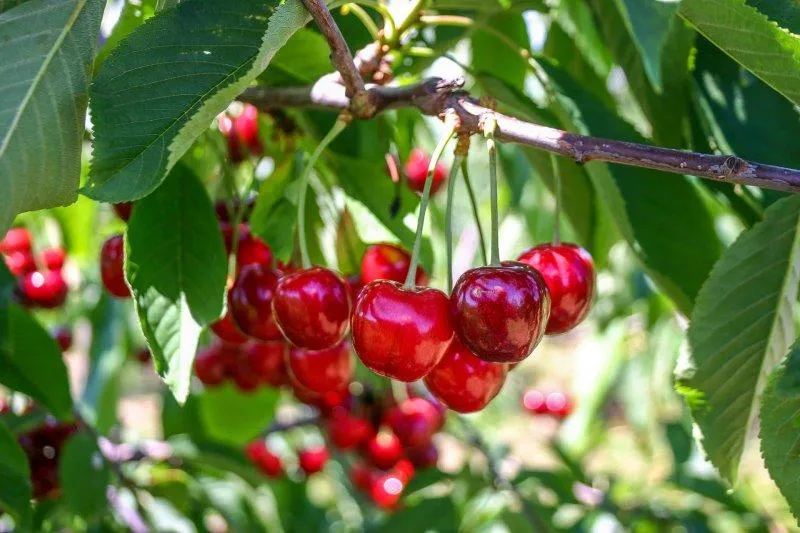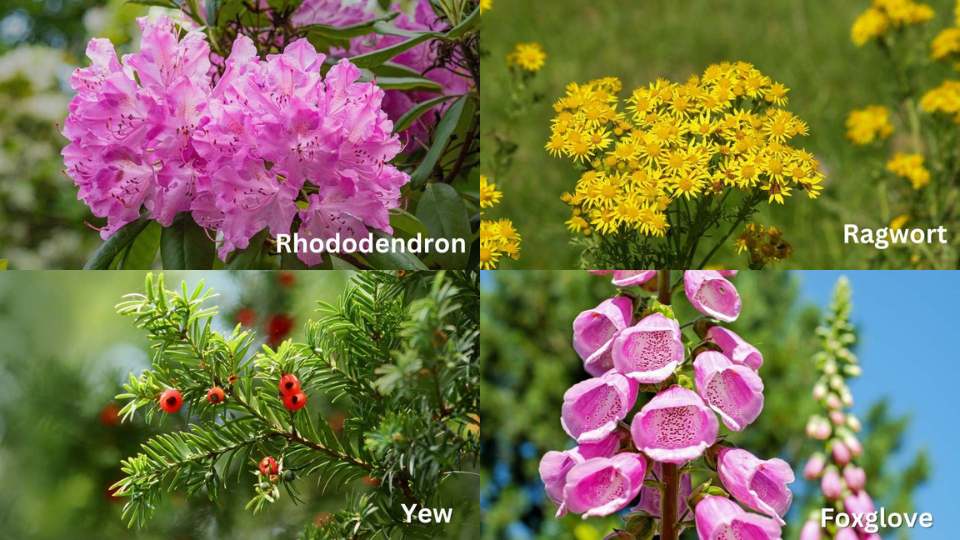
Plants toxic to livestock
Plants toxic to livestock
Wild parsnip & wild carrot (Trachymene spp)
Prunus (Cherry, Plum, Peach, Apricot)
Nitrate-Rich Crops (Brassicas, Ryegrass)
How to Prevent Toxic Plant Poisoning
New Zealand's lush landscape provides an ideal grazing environment for livestock, but it also harbors numerous plants that pose serious health risks to animals. This guide compiles information from veterinary case studies and expert advice to help lifestyle farmers identify, prevent, and respond to toxic plant exposure.
Plant toxicity in livestock
Risk factors
Wilted plants: Wilting concentrates toxins and can make plants more palatable.
Seasonal changes: Many plants become more toxic after drought, frost, or heavy rains.
Starvation: Hungry animals are more likely to eat toxic plants.
Young & naïve animals: They are more curious and have less resistance to toxins.
Environmental stress: Plants under stress (e.g., drought-affected) can increase toxin levels.
Species sensitivity: Goats, sheep, cattle, and horses react differently to various toxins.
It's not straightforward
Many farmers assume that plant toxicity is a simple 'is it toxic or isn't it' issue, but in reality, it is far more complex. The effects of a toxic plant can depend on numerous variables, such as:
Dose & exposure: Some plants only become toxic when eaten in large amounts, while others are dangerous in small doses.
Plant part consumed: The concentration of toxins can vary within different parts of the same plant (e.g., roots vs. leaves vs. flowers).
Growth stage: Some plants are more toxic when young or during rapid growth, while others increase toxicity when they mature or go to seed.
Climate & soil conditions: The toxicity of a plant can fluctuate based on environmental stress on the plant, soil nutrients, or previous droughts.
Tolerance: Animals that have been exposed to small amounts of a toxin over time may develop a degree of resistance, while naive animals are more susceptible.
Processing effects: Drying, fermenting, or wilting can increase or decrease toxicity. Some toxins persist in hay or silage, while others degrade over time.
Because of these factors, a plant that may appear harmless one year could cause a fatal poisoning the next. It is essential to remain cautious, regularly reassess pastures, and not rely on anecdotal evidence alone when determining what is safe for livestock to eat.
Common toxic plants in NZ

Ragwort
Description: A tall weed with bright yellow flowers, common in pastures, roadsides, and neglected fields.
Toxicity: Contains pyrrolizidine alkaloids, causing irreversible liver damage.
Animals affected: Cattle, horses (sheep and goats are more tolerant).
Symptoms: Weight loss, jaundice, neurological signs, liver failure.
Management: Remove before seeding, avoid wilting in paddocks, use biological control (e.g., Cinnabar moth).
Yew
Description: An evergreen tree with needle-like leaves and red berries, found in gardens and shelterbelts.
Toxicity: Contains potent alkaloids that cause sudden cardiac arrest.
Animals affected: Cattle, sheep, horses, goats.
Symptoms: Sudden death, difficulty breathing, trembling, collapse.
Management: Prevent access to yew trees and ensure clippings are never given to livestock.
Rhododendron & Azaleas
Description: Large, ornamental shrubs with bright flowers, common in gardens and shelterbelts.
Toxicity: Contains grayanotoxins, causing severe digestive and neurological issues.
Animals affected: Cattle, sheep, goats.
Symptoms: Vomiting (rare in ruminants), frothing, staggering, breathing difficulties.
Management: Keep livestock away from garden waste, remove rhododendrons from grazing areas.
Foxglove
Description: A tall plant with purple, bell-shaped flowers, found in forest edges, roadsides, and scrubland.
Toxicity: Contains digitalis, a toxin affecting the heart.
Animals affected: Cattle, sheep, horses.
Symptoms: Irregular heartbeat, diarrhea, convulsions, sudden death.
Management: Identify and remove foxglove from grazing areas.
Macrocarpa & Pines
Description: Common shelter trees, especially in farm hedgerows.
Toxicity: Contain compounds that restrict blood flow to the uterus, causing abortions.
Animals affected: Pregnant cattle, sheep, goats.
Symptoms: Late-term abortion, retained placenta, infection risk.
Management: Keep pregnant stock away from pruned branches.
Acorns & Oak trees
Description: Large deciduous trees with lobed leaves and acorns, found in paddocks on old farms.
Toxicity: Contain tannins, which cause kidney and digestive damage.
Animals affected: Cattle, sheep, goats.
Symptoms: Diarrhea, bloating, weight loss, kidney failure.
Management: Fence off oak trees, rake up fallen acorns, limit access in autumn.
Wild parsnip & wild carrot (Trachymene spp)
Description: Weedy members of the carrot family with feathery leaves and small white flowers, found in waste ground and paddocks.
Toxicity: Contains teratogens that cause birth defects in pregnant animals.
Animals affected: Sheep, goats.
Symptoms: Lamb deformities, joint abnormalities, bowed legs.
Management: Prevent pregnant animals from grazing wild carrot patches.
Prunus (Cherry, Plum, Peach, Apricot)
Description: Ornamental and fruiting trees with stone fruit, found in gardens and orchards.
Toxicity: Leaves contain cyanogenic compounds that release hydrogen cyanide (HCN) when wilted.
Animals affected: Cattle, sheep, goats.
Symptoms: Sudden death, bright red blood, difficulty breathing.
Management: Never feed wilted or storm-damaged prunus leaves to livestock.
Nitrate-Rich Crops (Brassicas, Ryegrass)
Description: Found in lush pastures after rain following drought.
Toxicity: Nitrate converts to nitrite in the rumen, blocking oxygen transport.
Animals Affected: Cattle, sheep.
Symptoms: Brown blood, gasping for air, sudden collapse.
Management: Use nitrate testing kits before grazing high-risk pasture, introduce slowly.
How to Prevent Toxic Plant Poisoning
Provide adequate nutrition, starvation increases the risk of toxic plant consumption.
Monitor paddocks for toxic plants. Identify and remove toxic plants before grazing.
Avoid feeding garden waste. Many toxic plants taste better when wilted.
Manage pregnant stock carefully and prevent access to pine, macrocarpa, and nitrate-rich crops.
Test pasture after drought, nitrate poisoning often follows rain after dry spells.
Plant non-toxic trees. Safe options include willow, poplar, and tree lucerne.
What to do if your animal eats a toxic plant
Move animals away from the toxic plant.
Prevent further absorption:
Administer activated charcoal (if available).
Give a demulcent (e.g., 4 egg whites to 1L whole milk) to coat the gut lining.
Provide paraffin oil to help pass toxins.
Monitor symptoms:
If vomiting, keep the animal upright and do not force oral fluids.
Watch for difficulty breathing, bloating, or staggering.
Call a vet immediately if:
The animal is gasping for air or has a weak pulse.
Vomiting or frothing occurs.
Symptoms worsen despite initial treatment.
Provide supportive care:
Offer tepid water with electrolytes.
Feed long-stem fiber (e.g., hay) to slow toxin absorption.
Conclusion
The best defense against plant poisoning is prevention. By staying vigilant, managing pastures well, and knowing which plants are hazardous, you can protect your livestock from unnecessary suffering.
Our online courses on keeping livestock are a great way to take the stress out of livestock farming.
What You Need to Know to Keep Livestock: our online course for lifestyle farmers covering practical, legal and day-to-day animal care.
What You Need to Know to Keep Cattle: a deep dive into understanding cattle and how to keep them happy and healthy.
What You Need to Know to Keep Sheep: from getting set up to day-to-day tasks to shearing - everything you need in one practical course.
What You Need to Know to Keep Goats: goats are great fun but can be tricky to manage. Get ahead of the play with this NZ-focused course.
Pigs Health & Husbandry: this course covers everything you need if you're keeping backyard pigs in New Zealand.
Alpaca Health & Husbandry: an online course where you can learn the essentials about keeping these amazing animals.

